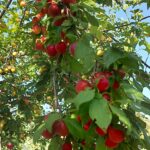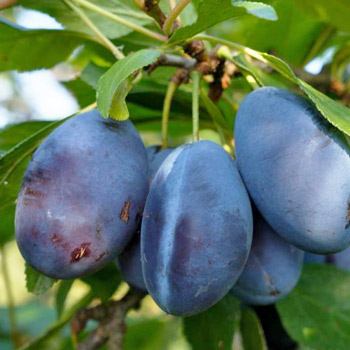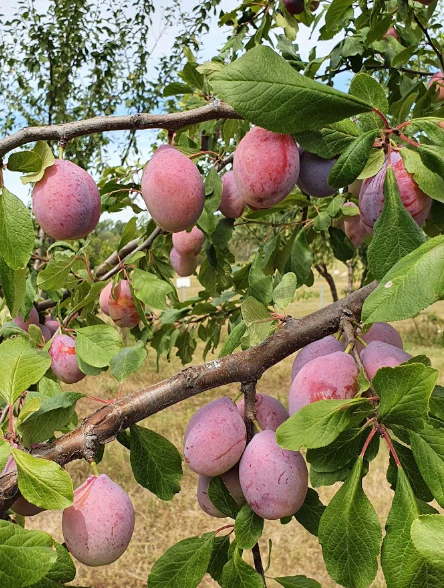STANLEY PLUM TREE
In local dialect “La vrugna”
Prunus domestica L.
Rosaceae
🍈STANLEY PLUM TREE AND ITS SWEET AND INTENSE FRUITS
Stanley plum tree (Prunus domestica L. ‘Stanley’) is one of the most common and liked varieties of European plum tree. It is known for its high productivity, its sweet fruits and its versatility in cooking. The Stanley variety is a perfect choice for both fresh consumption and drying.
It is not an ancient variety:
🌿 It was selected in 1913 in the United States, thanks to Richard Wellington’s studies, an agronomist at the Experimental Station of Geneva, New York.
📜 This type of prune is the result of a crossbreed of traditional European plum trees, and it has spread quickly in Europe and the entire world because of its resistance and the quality of its fruits.
🌍 Today it grows widely in Italy, France, Spain and the Balkans, especially for its use in the production of dried plums.
We included this tree in our orchard to compare it with its hardier relative and to evaluate its resistance in biological farming. In addition, its fruits are widely appreciated in our plum jam, which is a timeless classic. We also use the Stanley plums in our Amaretto-flavoured plums in syrup.
|
|
(PRUNUS CERASIFERA EHRH.) |
(PRUNUS DOMESTICA L. ‘STANLEY’) |
(PRUNUS DOMESTICA L.) |
|
Origin |
Europe and Asia, wild species |
Selected in the USA (1913) |
Ancient Italian variety |
|
Fruit’s shape |
Small and round shaped |
Oval and elongated shape |
Oval, slightly-tapered shape |
|
Peel’s colour |
Yellow-reddish or deep red |
Blue-violet with waxy patina |
Dark red with violet nuances |
|
Pulp |
Yellow and gold, juicy, sweet and sour |
Yellow and gold, solid, very sugary |
Yellow-orange, soft, sweet and fragrant |
|
Flavour |
Sweet and sour, fragrant |
Sweet, with honey aftertaste |
Very sweet, soft |
|
Kernel |
Small, clingstone |
Freestone |
Semi-clingstone |
|
Blossoming |
Very premature (March) |
April |
Late (April-May) |
|
Ripening period |
June |
September |
July-August |
|
Use |
Fresh consumption, rootstock for other types of plum trees |
Fresh consumption, dried plums, jams, liqueurs |
Fresh consumption, jams and desserts |
|
Resistance |
Hardy, resistant to cold and drought |
Cold tolerant, drought sensitive |
Sensitive to sudden climatic changes |
|
Curiosity |
It is often used as rootstock for other types of plum trees |
It is one of the most common types of cultivated plum tree |
It is a typical and very sought-after variety in central Italy |
📌To sum up:
- Cherry plum tree: this is a hardy and premature tree, perfect for those who are seeking a resistant plum tree.
- Stanley plum tree: this is a productive and adaptable tree, and its fruits are perfect for dried plums and jams.
- “Coscia di Monaca” plum tree: literally, its name means “nun’s thigh” and its fruits’ taste is mild and sugary. These plums are ideal for fresh consumption and desserts.



These contents were written and researched by the owners of the SiGi Agricultural Company in collaboration with the students of the Agricultural Technical Institute of Macerata.
If you would like to contribute to expanding the descriptions of these varieties, you can send an e-mail to info@agricolasigi.it
We launched the e-museum of ancient fruits thanks to a social farming project of the Marche region. The translation is by komalingua
This project enabled five young people with cognitive impairments, aged 20 to 25, to work on the farm. They were selected by psychologists and Anffas social workers, supported by the professional educator Il Faro and supervised by UniMc researchers. Coldiretti Marche handled communication and distribution.
This unique and challenging project led to the creation of both a physical and virtual museum of ancient fruits in SiGi’s garden. This is not only a great honor but also a significant commitment that we are willing to continue with everyone’s support. You can contribute to our projects by choosing our products, or you can do so directly here:
